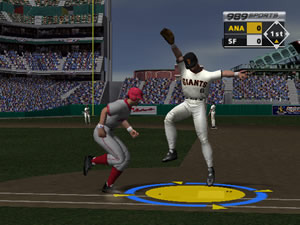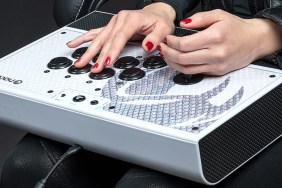A Lazy Pop-Up.
Watching baseball is like watching a piece of minimalist theater. A bunch of ‘players’ stand on a barren stage, while a pitcher and several batters engage in repetitive discourse: ‘Pitch,’ ‘Strike,’ ‘Pitch,’ ‘Ball’ and so on. When somebody finally gets a hit it’s practically proof of the existence of God since nothing has happened in so long. That’s why people feel compelled to drink at baseball games, to take their minds off their lack of worries. That’s also why 8 oz. of Coors Light cost a pound of flesh at most baseball parks.
And that’s why I like baseball video games – they’re so much more engaging. Every pitch means something, because you get to try and hit it, and every out is so painful, because the ball you hit was only feet from the wall.
Unfortunately,
playing Sony’s new MLB 2004 is about as fun as watching baseball thanks
to a mode scheme that suggests greatness, only to fall disappointingly short,
a terrible pitching/batting experience and a lackluster overall presentation.
MLB 2004 isn’t so much bad as depressing; it’s full of poorly implemented
great ideas. If 989 had just swung a little harder, this foul ball could have
been a homer.
MLB‘s modes are a fine mixture of the same and the new. Season, Career,
Franchise, All-Star game, Playoffs and Exhibition are here, as well as the Homerun
Derby. In Season you pick a team and play a season, in Career you control a
team or individual player for 10 seasons and try to make it/him better, and
in Franchise you pick a crappy team and attempt to make it rock through trades
and Farm team management.
However, the big new deal is Spring Training mode. In this mode you create
a player and enter him in Spring Training for the team you want him to play
for. The Create a Player aspect is simple and allows you to tweak several attributes,
though the effects of many are difficult to discern (Batting average? Clutch?
I know what a batting average is, but in this case it seems like the wrong choice
of words, since my player hasn’t hit a ball yet).
Your little Frankenstein then plays with the team in Spring Training games. Get hits, homers, and steals and you’ll get points. Get 50 points and your player moves into the majors. If he gets one hundred points there he gets to play in an All-Star game.
The most interesting aspect of Spring Training is the fact that it kind of
bridges three different modes: Spring Training, Season/Career and All-Star game.
However, your Spring player only gets one season in the majors to try for the
All-Star spot, and can’t be traded to other teams. Also, it doesn’t appear that
the player you created can be imported into the Career Mode or placed on your
team in the Franchise Mode. In fact, if you begin a Career Mode, your saved
Spring Training file must be deleted. Not only can you not unite the two modes,
but they’re mutually exclusive. Grrr.
Then there’s the pitching/batting dynamic. As the pitcher, you select the
pitch you want to throw, then press X to start the wind-up. If you tap X the
pitcher will throw the ball lightly, while firmly pressing X will cause the
pitcher to really put his back into it. Once the wind-up has begun you may move
the pitching cursor around the strike zone to place your pitch. Simple enough.
Batting is relatively complicated. Before the pitcher begins his wind-up,
you select between Power and Normal hitting. Normal hitting means a larger cursor
and less power, while the opposite is true for Power hitting. You can also attempt
‘Total Control Batting’ before the wind-up, in which you can guess at the pitch
type and location. Get both and you’re practically guaranteed a home-run. Get
one or the other and not much happens. Get neither and forget about swinging.
Against normal pitchers, you choose from one of four quadrants of the strike zone when predicting a pitch. Against great pitchers the strike zone is split into eight areas, making the likelihood that you’ll call the right spot most unlikely.
Total Control Hitting is crucial, because without the advantages it gives you, you’ll never hit anything but pop-ups or grounders. You’ll need to power hit and call the right pitch type to stand a chance. Fortunately, calling the right pitch isn’t very difficult if you just call the same one every time. After all, a pitcher has to throw a fastball, and when he’s about to you’ll know because your cursor will become larger.
 Unfortunately,
Unfortunately,
the ball comes off the pitcher’s hand at around 500 million miles per hour.
As a result, you basically have to swing as soon as the ball is released, leaving
you no time to actually watch the pitch. A cursor shows you exactly where the
pitcher is aiming during his wind-up, so you’ll know where the pitch is headed
before it’s thrown…provided the ball is thrown perfectly straight. It doesn’t
seem to take things like curves, slurves, sliders or sinkers into account at
all.
This boils down into a difficult guessing game. A pitcher will clearly aim outside of the strike-zone, but then throw a curve ball that takes the pitch inside the zone. But, since you don’t actually get to watch the pitch, you have to decide before it’s thrown whether or not it will actually be a strike. Confusing? Yes. Exasperating? Yes. Worth your time? Not a minute of it.
MLB‘s last major failing is its presentation and general appearance.
This game looks like how I felt the day after my 21st birthday. The stadiums
look terrible, the players lack detail, the animations are a choppy and CPU
pitchers take forever to throw. Each baseman has one animation that he always
uses for every grounder, and throws are never at a baseman’s chest; they’re
always at his toes or over his head, causing him to leap dramatically for the
ball.
The only pleasing visual MLB 2004 has to offer is the crowd, which
looks remarkably good. The stadium is packed full of individual 2D cheering
fans, who stand up and sit down and clap and everything. How about that.
Aurally, MLB is unimpressive. The sound effects are par for the course
and there’s some stadium music and announcing, but they don’t amount to much.
After the last ridiculously fast pitch is thrown and the last batter has grounded
out, 989’s MLB 2004 is probably the most flawed baseball game available
for a modern system. However, if the Spring Training and Career modes were effectively
integrated and the batting game was drastically improved (slow down the pitches!),
we’d have something to cheer for. Instead, what we have is a game that simply
cannot compete with the likes of World
Series Baseball 2K3. On the bright side, MLB 2005 has a chance at
being the most improved player in baseball gaming history.

-
Coolest crowd in baseball
-
Interesting ideas
-
Most of which fail
-
Pitches are WAY too fast
-
Awful graphics











